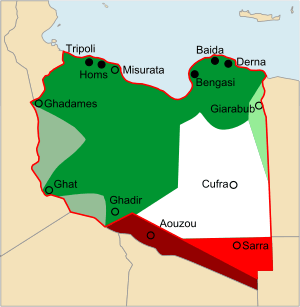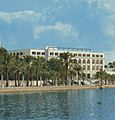Italian Libya facts for kids
Italian Libya was a colony of the Kingdom of Italy. It existed from 1911 until 1947. Italy took control of Libya in 1911 from the Ottoman Empire. Many Libyan people, especially Muslims, continued to fight against the Italian forces for several years. This fighting was particularly strong during World War I.
The fighting became even more intense after Benito Mussolini became the powerful leader, or dictator, of Italy. Idris, who later became the King of Libya, had to leave the country and went to Egypt in 1922. From 1922 to 1928, Italian forces, led by General Badoglio, carried out a harsh campaign to stop the resistance.
After General Badoglio, Rodolfo Graziani, a high-ranking military leader called a Marshal, took over. He told Mussolini he would only accept the job if he could crush the Libyan resistance without following Italian or international law. Mussolini agreed right away, and Graziani made the oppression much worse. Some Libyans kept fighting for their freedom. The strongest resistance came from the Cyrenaica region. A tribal leader named Omar Mukhtar became the main leader of this uprising.
After a short break in fighting in January 1928, Italy's actions in Libya became a full-scale war. They even moved people from northern Cyrenaica into special camps. This was done to stop the local people from helping the rebels. Omar Mukhtar was captured on September 15, 1931, and then executed in Benghazi. After his death, the resistance slowly ended. However, some limited resistance against the Italian rule continued around Sheik Idris, who was the leader of the Sennusi tribe in Cyrenaica.
Contents
How "Libya" Was Formed
By 1934, the fighting in Libya had mostly stopped. The new Italian governor, Italo Balbo, began a plan to bring Arabs and Italians closer together. New laws in 1939 allowed Muslims to join the National Fascist Party. They could also join a group called the "Muslim Association of the Lictor." The changes in 1939 also allowed Libyans to join military units within the Italian army. This led to many Muslim Libyans supporting Italy during the North African Campaign of World War II.
Uniting the Regions
Governor Balbo officially created "Libya" in 1934. He did this by joining three regions: Tripolitania, Cyrenaica, and Fezzan, into one country. From 1934 to 1940, he worked to develop this new "Italian Libya." He built a lot of important things, like 4,000 kilometers (about 2,500 miles) of roads and 400 kilometers (about 250 miles) of narrow railways. He also started new industries and built many new farming villages.
Economic Growth and Improvements
The economy in Libya grew well, especially in farming. Some factories were also built, mainly for making food products. Many new buildings were constructed. The Italians also brought modern medical care to Libya for the first time. They improved health conditions in the towns. They also created many travel connections to Italy by sea and air. One example was the "Linea dell'Impero," an air route that linked Libya with Rome and with Ethiopia/Somalia.
Historian Howard Christie wrote about the many different businesses the Italians started in Libya. These included factories for explosives, railway workshops, and Fiat car works. There were also food processing plants, electrical workshops, and ironworks. Other businesses included water plants, farm machinery factories, breweries, and bakeries. These investments helped the colony become more self-sufficient. By 1940, about 110,575 Italian people lived in Libya, out of a total population of 915,440.
Governor Balbo also supported building many new villages. These villages were for thousands of Italian colonists who moved to the coastal areas of "Italian Libya." New villages were also built for the Arab people.
Libya in World War II
Libya became an important place for fighting during World War II. On September 13, 1940, Italian forces used the "Via Balbia," a major highway in northern Libya, to invade Egypt. British and other Allied forces from Egypt, led by Wavell, then launched a successful two-month campaign. They took back places like Tobruk, Bengasi, and El Agheila.
Rommel led counterattacks for Germany and Italy from 1940 to 1943. However, in November 1942, the Allied forces took back Cyrenaica. By February 1943, the last German and Italian soldiers were forced out of Libya.
Images for kids
-
Indian soldiers talking with local people in Derna in December 1941.
-
Governor Italo Balbo welcoming Italian colonists as they arrive in Tripoli.
-
Tripoli Cathedral and the former FIAT center (Meydan al Gaza'ir) in the 1960s.
-
The Eni Oil Bouri DP4 platform in the Bouri Field. It is the biggest oil platform in the Mediterranean Sea. Italy is now Libya's most important trading partner.
See also
 In Spanish: Libia italiana para niños
In Spanish: Libia italiana para niños




















